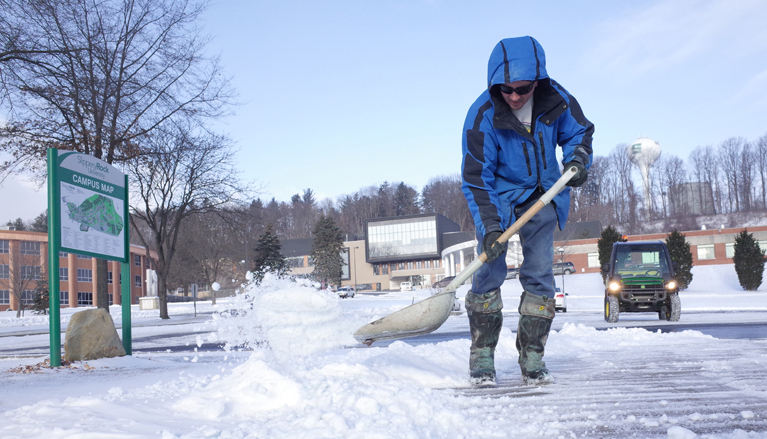SNOW KIDDING

Winter crews dig in to prevent a ‘slippery’ Rock
Jan. 19, 2016
SLIPPERY ROCK, Pa. - With jam-packed schedules, including classes, work and extracurricular activities, it's not unusual to see students sprinting across campus. It's also common to see them focused on their smart phones, sending and fielding text messages on their travels.
Both conditions can lead to slipping and a sliding during winter. Slippery Rock University's labor and grounds department crew is committed to doing their best to make sure that doesn't happen.
"Our main concern is campus safety, for the students when they're coming to classes, for the staff members and faculty. Everything we do is to make sure, given our resources, we make sure campus is as safe as possible," said Dallas Cott, assistant director of campus services.

As the second semester begins, Cott, who manages snow removal, said an effective response team is in place to anticipate and react to storms. Fifteen full-time and three part-time employees shovel and plow the white stuff. SRU deploys five trucks with plows, five tractors with plows and salt spreaders and a new utility vehicle to remove snow from campus roadways, parking lots and sidewalks, he said.
The University is under contract for 560 tons of bulk road salt and 66 tons of an ice melt blend for sidewalks. Crews, canvassing campus in vehicles, do a lot of the shoveling by hand.
If necessary, labor crews work after hours, even overnight, Cott said.
"We're out there," Cott said. "When it snows, the people who operate the equipment will come in at 5 a.m. The hand shovelers come in at 6 a.m. But if we get a huge snow, it could be earlier than that. It could be 1 a.m. or it could be 2 p.m."
One of the challenges with snow removal, Cott said, is storms hit at all hours and are of varying lengths, accumulation and ice.
"It's very complicated," he said. "Every storm's different. You can have a powdery snow. You can have a wet snow; you can have an icy snow. That all changes how it reacts to the salt, how our equipment reacts."
In terms of volume, Cott said snow removal teams cover 10 miles of roads in one direction, 12 miles of sidewalks in one direction, 40 acres of parking lots and 1,000 steps that must be manually shoveled.
"We bring in this crew early depending on weather, and they will stay late or be called out at night as weather dictates," he said.
Another challenge is frigid air. Rock salt is slower to work, or ineffective, at 20 degrees or less. "We put it down, and we have to have some sun, vehicle or foot traffic to generate a little heat," he said.
A wintery mix wreaks havoc, too. It might be raining on one end of campus with freezing rain on the other, he said.
With 2,000 students living on campus and others coming and going, Cott said students should proceed with caution if they happen to be in the path of nasty elements. SRU, which recently concluded a comprehensive review of its weather policy, has tried to prepare for all types of severe weather conditions.
"My recommendation for ice is take baby steps or even walk off the sidewalk whenever we get freezing rain," he said. "Walk on the grass, that's where you'll get a little more traction. Wear appropriate footwear, instead of the flip-flops and high heels that we see too often. Pay attention."
When severe weather threatens, a team comprised of representatives from the University Police, facilities and communication and public affairs is charged with assessing the situation and advising the president and provost as to whether or not classes should be canceled, if a two-hour delay should be implemented or if the University should open, remain open, close or be on a two-hour delay.
According to the University Weather Policy, should the University close for a severe weather event, the closing applies to all campus locations and to all academic and extracurricular activities, including athletic events, plays, performances, guest lecturers and campus rentals.
Once a decision is made to delay classes, or to close the University, the communication and public affairs staff kicks into high gear to notify the media, send out e2Campus alerts, post the information to social media, alert the University switchboard, send a campus email and put the notification on the University homepage.
Cott, who has a weather app on this phone, said he and other supervisors monitor weather overnight when necessary. They text and call each other until administrators get involved as early as 4:30 a.m. to make a decision.
"Snow removal operations is one of the most difficult things we do," Cott said. "I am very confident in our operations. We're here all the time. We have decent equipment. We have all the supplies we need. The crew is very dedicated to campus safety. They take their job seriously and they're here when needed. The ultimate goal is safety for the students."
Campus officials advise all members of the University community should be aware of the University's weather policy and the compressed schedule that would be utilized should conditions cause a delay in the regular class schedule. They also encourage all students, faculty and staff to sign up for e2Campus alerts so that they'll receive information as son as it is released.
To access the University's Weather Policy, visit: http://www.sru.edu/Documents/web/University-SevereWeatherPolicy.pdf
To access the University's Compressed Class Schedule, visit: http://www.sru.edu/Documents/web/compressed-class-schedule.pdf
To sign up for e2Campus alerts, visit:
http://www.sru.edu/offices/university-communication-and-public-affairs/e2campus-alerts
MEDIA CONTACT: Gordon Ovenshine | 724.738.4854 | gordon.ovenshine@sru.edu

